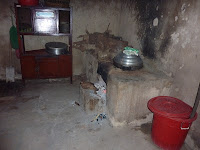The Cu Chi tunnels were in a different league and, for me, utterly absorbing. I haven't got time to describe the whole complex in detail or its history, so here is a brain dump of some of the salient facts.
- The Ch Chi area covers some 160 square kilometres and is situated about 75k north west of Saigon.
- It is only 25k from the village where the picture of the burning girl was taken.
- The US wanted to establish a base there, as it would have been a good site for protecting Saigon.
- The tunnels themselves were built by the VC as a way of hiding from the Americans and run for some 250k, right down to the Saigon river, branching out in many directions.
- The VC included both men and women and very many gave up their lives for the cause.
- The entrances to the tunnels were very well hidden.
- The tunnels were very narrow, so most Americans would not be able to get in. If they did, they would likely as not fall into traps built within the tunnels themselves.
- The subsoil is heavy clay, which meant they could, with difficulty, dig with small spades. It also meant that there were few tunnel collapses.
- The tunnels were on three levels (see diagram). The first were largish rooms, just underground. These were used for things such as cooking and first aid. The second and third provided better levels of protection.
- As they dug, they had to get rid of the soil, else the US would see where they were. They either filled in the bomb craters with the extracted soil or put it in the river.
- Some people lived in the tunnels for up to 18 years. Many were born there.
- The VC were incredibly ingenious in the ways they found to deceive and fight the Americans.
- Other villagers, mostly women and children, lived above ground, but were totally supportive of the VC below ground.
- Below ground, mostly they slept during the day, coming out at night to tend to their limited crops or to attack the Americans.
- The wore black uniforms, providing maximum camouflage.
- The US did everything they could to clear out the area, bombing it frequently, with high explosives, Napalm and Agent Orange, and sending in masses of ground troops, but they never managed to clear out the VC.
- We saw a demonstration of how they disguised the holes and could quickly retreat into one, should an American come close.
- The VC laid many traps in the jungle, of many different types, to catch the Americans. These were quite horrific, but mostly resulted in the soldier falling into a hole that was full of bamboo spikes, or, occasionally, iron spikes.
- The VC did not put poison on the spikes, as they wanted to inflict as much suffering as possible.
- They could not use kerosene or candles underground as these burnt too much oxygen. They therefore used lamps filled with cashew or peanut oil. I'm not sure I believe the reason. Maybe it was that they used what was available (Vietnam is now the world's largest producer of cashews).
- They cooked underground, but couldn't afford to be given away by the smoke. Their solution was to build smoke tunnels exiting 200 metres or more from the kitchen. The outlet was covered with fresh leaves each day, the old leaves being taken back to the tunnels as fuel.
- Clearly, the tunnels needed venting, but the VC could not afford to have the vents discovered since the Americans would pump in chemicals or drop grenades into any vents they found.
- The VC's way of hiding the vents was to exit each in a termite's nest, of which there were many. They also built imitation nests, which looked identical to the real thing, and exited some vents in these, as well.
- The Americans started using dogs to smell out the vents, having trained them to smell Vietnamese. The dogs would bark when they found a vent.
- The VC retaliated by putting chilli and pepper round the vent. This irritated the dogs and made them sneeze, so they didn't bark and the Americans didn't find any vents for some months.
- When they realised that the dogs didn't sneeze when they got back to base, they realised what was happening and so they then looked for dogs that sneezed. This gave them the upper hand again and they cleared out more tunnels.
- The VC retaliated by hiding captured American uniforms near the vent, which confused the dogs so they didn't go near the vent. And so it went on, a right old arms race, but on a very different level.
- There were no toilet facilities underground and so the VC trained themselves only to go at night. Then they went down to the river.
- The conditions inside the tunnels were, of course, atrocious. They were infested with rats and insects and many VC died of malaria and other diseases.
- When they found unexploded bombs, the VC would saw them in half to extract the explosive. This was very dangerous and in about half the cases resulted in setting off the bomb.
- They made sandals from old tyres.
- Although the jungle foliage has recovered to a great extent, it is nowhere near as thick as it was originally. The Napalm and Agent Orange virtually cleared it completely.


There’s a YouTube video that includes a view of the tunnels. It can be found at: http:\\www.youtube.com/watch?v=azxnc1nDkos
Here’s website about the war in general:
http://www.diggerhistory.info/pages-conflicts-periods/vietnam/tunnels.htm


No comments:
Post a Comment